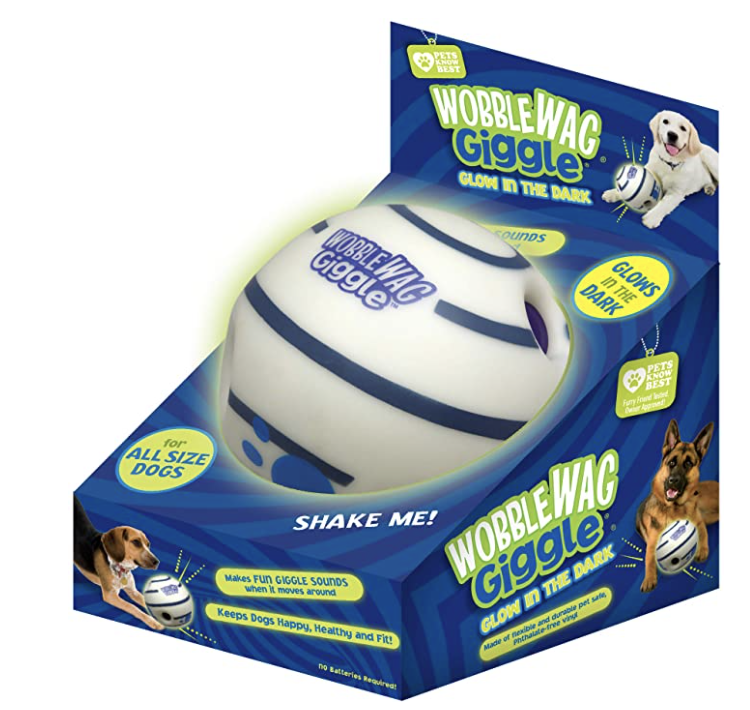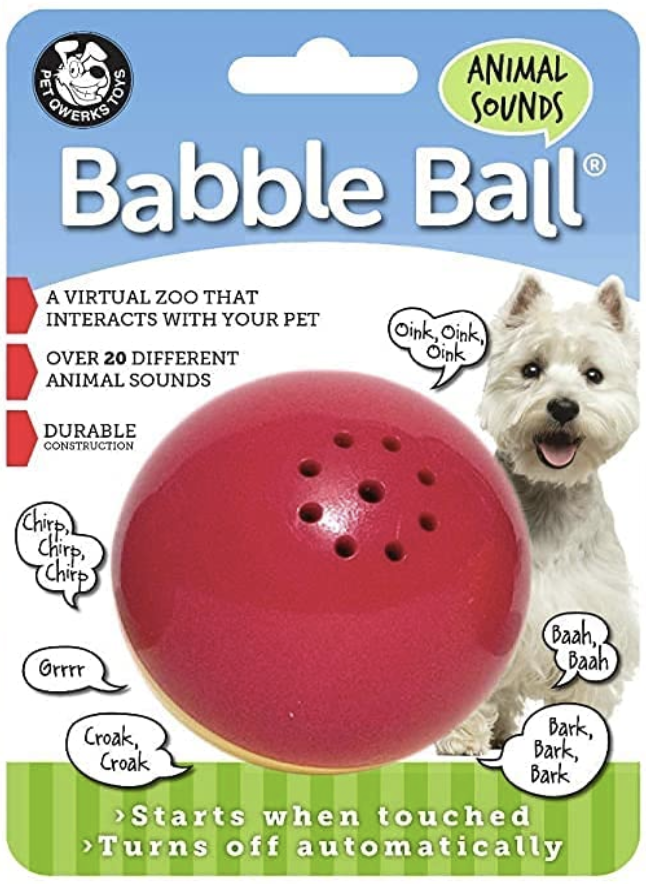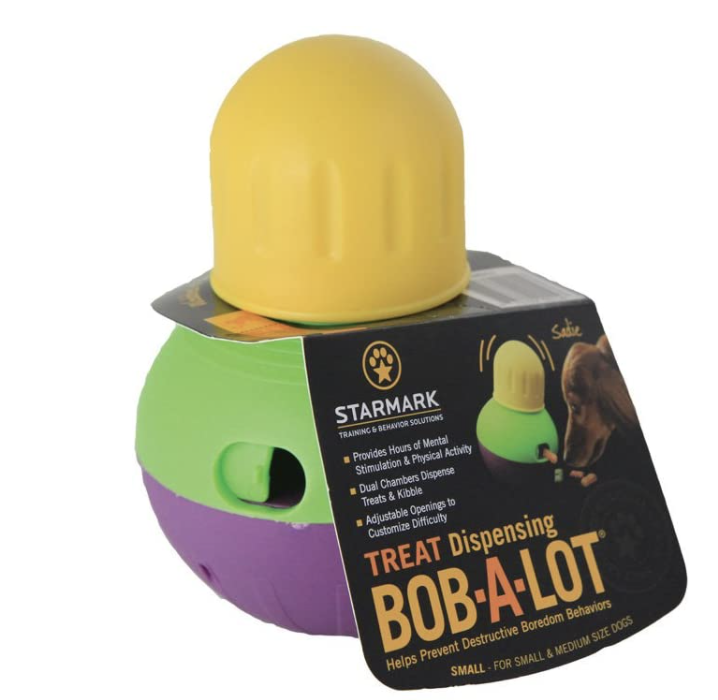What Really Causes Blindness in Dogs? Experts Share the Warning Signs
A dog’s ability to see shapes how they experience their surroundings and connect with those they love. Yet this depends on the health of the entire eye, and diseases such as diabetes can disrupt normal function.
Some of these diseases that can cause blindness in dogs include:
- Glaucoma
- Cataracts
- Diabetes
- Breed specific
- Injury
- Infection
- Chronic dry eye
Unlike humans, dogs don’t rely on vision as their most vital sense. They’re good at adapting to gradual blindness. Their noses and ears allow them to adjust well to changes in their vision, and as a result, it can be difficult to notice if your dog is blind.
Blindness in dogs can be distressing and traumatic for both you and your dog, especially if it becomes sudden or complete blindness.
Dogs can also develop gradual blindness over several months or years. This gives you enough time to figure out
why your dog is losing vision, if treatment is available, and develop a plan of taking care of your canine’s changing needs.
How to Tell if Your Dog is Going Blind
Unless they’ve suffered a major injury, blindness in dogs occurs so that it can be difficult to recognize the signs.
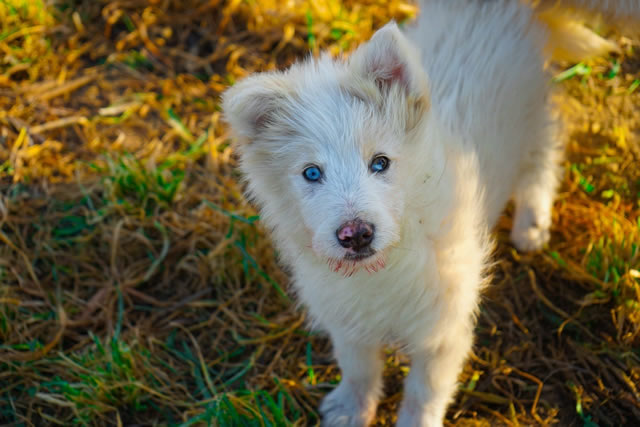
Signs of blindness vary from case to case, depending on what caused it. But if you know your furry friend well, you can tell early.
“The most common sign would be bumping into stationary objects. Other signs could be that the dog used to catch things from mid-air and no longer is able to do so.”
Dr. DJ Haeussler, Veterinary Ophthalmologist.
There are a few telltale signs of blindness in dogs, and it’s essential to be aware of these before they become permanent.
- Not reacting when called or when someone approaches them
- Walking into things or bumping into walls
- Collapsing for no apparent reason
- Showing a decreased interest in playing or being active
- Cloudy eyes
- White spot on the eyes
- Difficulty in finding food, water, or toys
- Too much sleep
- Depression
- Anxiety and fear
- Avoiding stairs
- Swelling and redness around the eye
- Enlarged pupils
- Not making eye contact with you
- Refuses to go outside
- Confusion
- Sticking to the same room
- Lack of responsiveness to light
If your dog is experiencing any of these symptoms, it’s important to take them to a vet as soon as possible.
During your appointment, express your concerns and some behaviors you’ve observed. A veterinarian will examine your dog, perform tests, and make a diagnosis.
Healthy Dog Eyes Vs. Unhealthy Dog Eyes
The key difference between healthy and unhealthy dog eyes is the color of their sclera, conjunctiva, iris, and pupil.
It’s important to regularly examine these parts of your dog’s eye to ensure they’ve developed no infection, debris, or spots.
Checking your dog’s eyes can help you notice a more severe disease before it causes permanent blindness.
“[Owners] should pay attention to their pet’s ability to navigate around the house in different light settings as this can be an early sign of retinal degeneration. Most importantly, any form of ocular discomfort like rubbing at the eye, squinting or increased redness, tearing or cloudiness should be evaluated by a veterinarian immediately.”
Dr. Erin Scott, Texas A&M College of Veterinary Medicine & Biomedical Sciences.
Use the table below to help you determine if your dog’s eyes are normal or abnormal.
| Parts of the eye | Healthy dog eyes | Unhealthy dog eyes |
| Sclera (white part) | Glistening white with small, thin red blood vessels |
|
| Conjunctiva (pink tissue) | A shade of pink as gums |
|
| Iris | Clear |
|
| Pupil | Same size and constricts to a pinpoint when light is shined |
|
A dog may appear to go blind overnight in rare cases, but blindness usually develops over several months or years.
Many different things can cause dog blindness. We’ve discussed three major reasons your dog may be going blind.
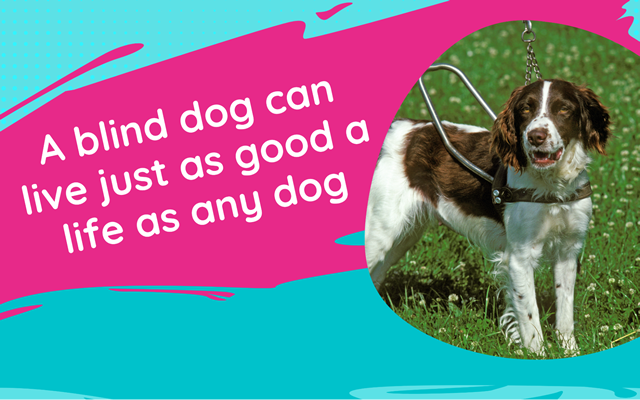
Glaucoma
Glaucoma is a painful condition that can lead to complete blindness in dogs if left untreated.
Glaucoma is a condition that develops when the eye cannot drain fluid properly. This leads to increased pressure within the eye, which damages the optic nerve and retina.
This increased pressure leads to pain, followed by gradual vision loss and—in severe cases—blindness.
The disease is commonly seen in breeds such as poodles, cocker spaniels, terriers, and miniature schnauzers.
In dogs, glaucoma can be inherited, or it can be caused by injury or infection.
Glaucoma can also be caused by other diseases, such as diabetes and high blood pressure, that affect the dog’s blood vessels and other parts of their body.
There may be no visible signs when glaucoma occurs in the early stages. The dog is suffering a progressive reduction of its visual fluid, but it’s adapted without causing excessive problems.
However, the symptoms are always evident when it’s already advanced or from an acute glaucoma attack. The dog experiences severe pain in the affected eye, very red eyes, blurry vision, excessive tearing, vomits, and the dog may be aggressive.
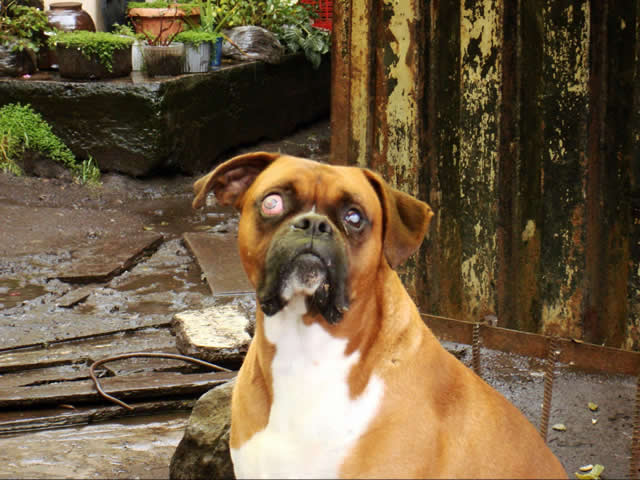
Treatment of glaucoma depends upon each dog, though normally, the veterinarian will recommend applying a specific eye drop to keep the intraocular fluid under control.
The vet may also prescribe analgesic or anti-inflammatory medications, especially when glaucoma is causing severe pain.
Some dogs respond well to eye drops and do not need any other treatment. However, other dogs may need surgery in addition to eye drops. Surgery can involve draining some fluid from the eye or removing part of the lens.
If you think your dog has glaucoma, contact your veterinarian immediately. Prognosis depends on how soon treatment begins.
Cataracts
A cataract is a cloudiness or opacity that develops in the eye’s lens, which interferes with light transmission, causing vision problems.
Cataracts start small, and there’s no pain associated with them, so you may not notice their onset. They’re often hereditary, but trauma, diet, toxins, medications, or infection can cause them. Cataracts are common in older dogs but can also occur in younger ones.
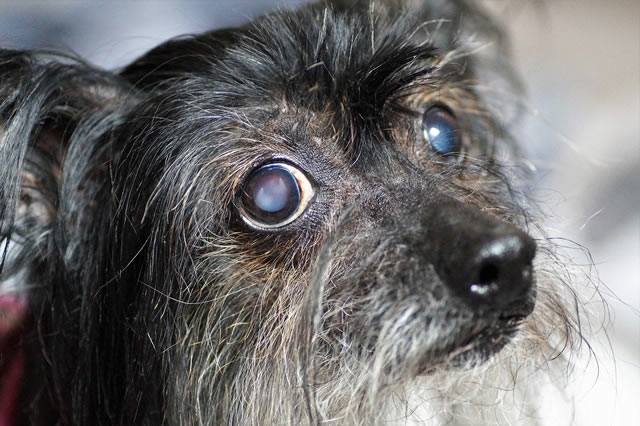
The breeds predisposed to developing cataracts include Miniature Poodles, Cocker Spaniels, German Shepherds, Golden Retrievers, Rottweilers, Labrador Retrievers, Dobermans Pinschers, and Siberian Huskies.
The symptoms of cataracts include difficulty seeing in low-light conditions, increased sensitivity to light, cloudiness within the eye’s lens, increased pupil dilation, and vision changes. There will also be a noticeable change in the consistency of your dog’s eye color as well.
If caught early, cataracts can be treated through a process known as cataract surgery. This is a common surgical procedure performed by an ophthalmologist (eye specialist). The goal is to remove the lens that has become cloudy and replace it with an artificial one.
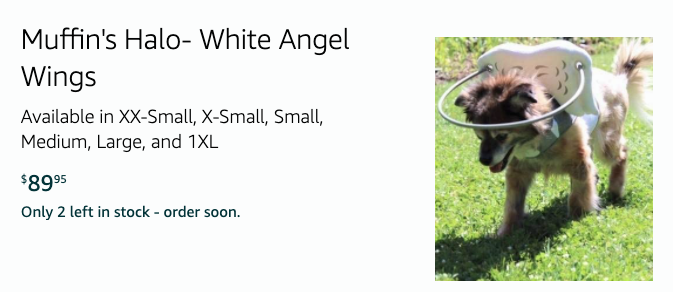
Chronic Dry Eye
Dogs can develop dry eyes the same as humans. It’s a condition where the tear film becomes either too thin or too thick, causing discomfort and vision problems.
Also known as Keratoconjunctivitis sicca, chronic dry eye is an uncomfortable condition, and your dog’s body will do various things to ease the discomfort. For example, your dog will produce mucus instead of tears and gradually infiltrate vessels, tissue, and pigment over the eye’s surface to provide protection.
The condition can be caused by several factors, including inadequate tear production, inflammation, blockage in the eye’s drainage system, age, breed, and environment.
Some breeds of dogs, such as Bulldogs and Shih Tzus, are more prone to the condition than others. Exposure to dry air or wind can also contribute to the development of keratoconjunctivitis sicca.
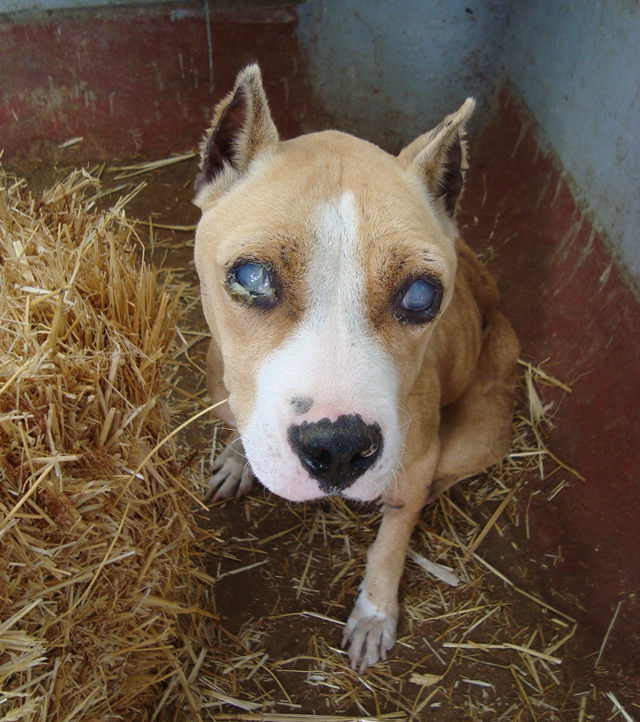
Dogs with keratoconjunctivitis sicca may experience excessive blinking, redness and inflammation in the eye, discharge from the eyes, and sensitivity to light.
Treatment includes eye drops, ointments, and artificial tears. Your dog may require surgery to correct the tear drainage system in severe cases.
Related: Want to meet an adorable blind dog that’s full of life? Come meet Kobe
Kobe is also very picky. Watch a video of him picking his best toy.
How to Take Care of a Blindness in Dogs
Blind dogs are not only adorable and kind, but they can also be a lot of fun to own. However, caring for your blind dog takes a bit of extra work. If you want to ensure your dog has a happy life with you for as long as possible, there are things you can do to help them transition into blindness.
“Even a blind dog can find a bone every so often.”
Alexei Sayle
Treat Your Dog Like a Baby
When caring for your blind dog, you’ll want to treat him like he’s an infant. Instead of leaving him out in the yard or his kennel for hours on end, bring him inside with you whenever you’re home. This lets you watch them and ensure they’re safe. Don’t leave them unattended in their crate while you’re away at work because they could hurt themselves or get into things that they shouldn’t.
“A blind dog requires more care and supervision than a seeing dog, and owners often find themselves in the position of being the seeing-eye-human for their blind dog.”
Danica Lucyshyn, Western College of Veterinary Medicine.
Keep Your Blind Dog Busy
Your dog’s life should still be filled with fun activities even if they can’t see them anymore. Take them on walks around the neighborhood so they can enjoy the fresh air and listen to the sounds.
Take your Blind Pup to a Pet Supply Store and Allow Them to Choose Anything they Want
Blind dogs love to play just as much as the next puppy. Treat and pamper your dog by taking them to a pet supply letting them participate in filling your shopping cart. Your blind dog will use their smelling sense to stimulate their mind. Instead of deciding on your own what your furry friend might enjoy, let them have fun deciding what’s good for them.
I have actually lived with three blind dogs so I’ve definitely learned a thing or two. I wrote an article with all the advice, tips and tricks of living with a blind dog so hopefully it will be a more straight forward process for you.
Here’s a video of me having fun buying Willie all the toys and treats he touches just so he knows he’s loved.
Watch for signs of stress or confusion from your pet
If your dog seems uncomfortable with its new disability, you may want to take it to the vet for a check-up. The vet can make sure the discomfort is not caused by an illness or another problem in addition to blindness.
A dog who is going blind may feel fearful, unsure, and confused, but they can still live happily and healthily in your home; provided you’re willing to put in the time, energy, and financial support to ensure your pet’s eyesight does not deteriorate any further or hinder its well-being.
Adoptable Dogs Near You

